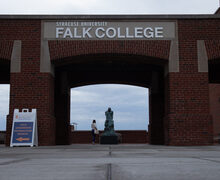Seasonal depression more than just ‘winter blues’
Daily Orange File Photo
The risk of seasonal depression also varies depending on factors like gender, location, family medical history, personal health and age.
Seasonal affective disorder can have real and serious impacts on Syracuse University students’ quality of life, yet our society tends to dismiss it like it’s some made up mental health issue.
The way society talks about seasonal affective disorder only trivializes the reality of the disorder. And it’s these attitudes that make it challenging for people who actually suffer from the disorder from speaking out and getting the help they need.
People need to change the way they think about seasonal depression. It’s more than just “cabin fever” or “the winter blues.”
About 5% of adults in the United States suffer from seasonal affective disorder, better known as “seasonal depression” or “SAD,” according to the American Psychiatric Center.
The mental health disorder is a type of depression that comes and goes each year, usually starting in the fall, intensifying in the winter and going away come spring. An uncommon form of seasonal depression, better known as “summer depression,” starts in spring and ends in the fall.
Common symptoms of seasonal depression include trouble focusing, fatigue, feelings of sadness, changes in sleep, an increase in restless activity, changes in appetite and lack of interest in activities once enjoyed, according to the American Psychiatric Center. Symptoms can vary from mild to severe.
Benjamin Domingo, director of SU’s Health Services, said less exposure to the sun has the potential to affect students academically, socially and physically.
“It can affect student life because it can be easier to miss class because you really are unable to get up in the morning,” said Domingo. “It can affect people socially because they’re less willing to go out, and you know, interact with others. It can affect them physically because of weight gain. About 65% of people who have seasonal affective disorder gain weight during that time frame.”

Karleigh Merritt-Henry | Digital Design Editor
The risk of seasonal depression also varies depending on factors like gender, location, family medical history, personal health and age. For example, seasonal affective disorder is diagnosed four times more in women than men. It’s also more prevalent in northeast states than those farther south. Younger adults are known to be more likely to develop seasonal depression.
In a 2017 study of about 48,000 college students, 64% of students reported that they had felt “very lonely” in the previous 12 months. Only 19% said they never felt lonely, according to the American College Health Association.
These preexisting feelings of loneliness and stress can make certain people more vulnerable to the effects of seasonal affective disorder. And the ways in which they cope with these feelings, or the sorts of behavior that might perpetuate them, often impact the degree to which seasonal depression takes hold.
Data from the National Surveys on Drug Use and Health shows that 3.5 million full-time college students engage in binge drinking, 1.2 million engage in heavy alcohol use and 2 million used an illicit drug in the past month. College is often the time when young people begin to engage in substance use.
The relationship between seasonal depression and substance abuse is bi-directional. People who are depressed may abuse drugs to escape reality, while people who abuse drugs or drop drug habits may be more likely to become seasonally depressed.
Though the precise causes of seasonal affective disorder remain unknown, research has found some clues, including your sleep-wake cycle and hormone levels.
The reduced level of sunlight in fall and winter can disrupt your body’s internal clock, cause a drop in serotonin, and disrupt the balance of the body’s level of melatonin, according to the Mayo Clinic.

Karleigh Merritt-Henry | Digital Design Editor
Les A. Gellis, Ph.D., associate teaching professor of psychology in the College of Arts and Sciences, recommends getting sunlight in the morning.
“If you can get bright light in the early morning, hopefully that will help reset that clock, and so, you’ll be able to have a regular sleep pattern, which may make it less likely that either you’ll be susceptible to it or potentially have treated it as well,” Gellis said.
Moreover, if for some reason you are unable to get natural sunlight, there are instruments available to mimic natural light. Light therapy is deemed the most-effective treatment for seasonal depression.
Domingo recommends spending 20 minutes in front of a light therapy box in the morning at the Barnes Center at The Arch, but said further action may be needed for more serious cases of seasonal depression.
“People with more severe cases, there’s obviously some medication choices but it’s not really an either-or,” said Domingo. “If someone had a severe case you would want them to do all those things including psychotherapy, but specifically, cognitive-behavioral therapy because that really just helps you reframe things,” said Domingo.
If you feel you have seasonal affective disorder, contact your physician. With treatment, seasonal affective disorder is a manageable condition.
Seasonal depression is no joke, especially when college students in the Northeast often have traits and live in environments that make them especially prone to it. Seasonal depression knowledge and awareness is crucial for SU students to thrive during college.
Jenna Wirth is a sophomore magazine journalism major. Her column appears bi-weekly. She can be reached at [email protected]. She can be followed on Twitter @jenna__wirth.
Published on November 5, 2019 at 12:05 am




